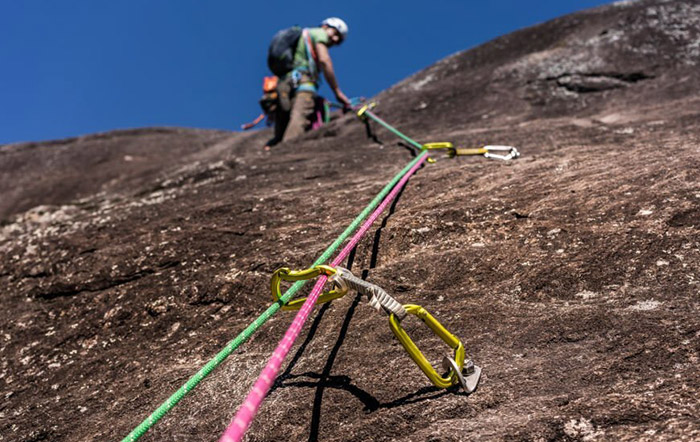Ropes come with a variety of applications, including lifting heavy loads and securing boats to docks. However, the rope’s strength is not unlimited, which means it is essential to know how much a climbing rope can hold. A rope’s weight depends on various factors, such as the type of rope, diameter, construction, and current condition.
But in general, climbing ropes are designed to have a minimum breaking strength of 5000 pounds (22 kilonewtons), which means they can support much more weight than most climbers will ever put on them. A lead climbing fall generates around 450 to 1125 of force. But most of the climbing ropes can handle over 2600 lbs and will break when over 5500 force is used.
This article will give an overview of the various factors that affect the weight-bearing capacity of a climbing rope.
Contents
Factors Affect Weight-Bearing Capacity
Type of Rope
One factor that influences the weight-bearing capacity of a rope depends on whether the rope is static or dynamic. Static ropes are designed when the rope is under tension but do not stretch significantly. These ropes are generally made of synthetic fibers, such as nylon, polyester, or Dyneema, which provide excellent strength and durability.
On the other hand, dynamic ropes are designed to stretch under tension, making them ideal for absorbing the impact of falls in activities like mountaineering and rock climbing. A dynamic rope’s weight-bearing capacity is lower than a static rope’s.
Rope Materials
Ropes are made from various materials, including natural fibers such as hemp, sisal, and cotton and synthetic fibers such as nylon, polyester, and polypropylene. Each of these types of ropes has unique characteristics that affect the rope’s strength.
Natural Fiber Ropes
Natural fiber ropes are naturally less strong than synthetic ones, but they have more flexibility and are much easier to handle. They are also less expensive than synthetic tropes. The strength of natural fiber ropes depends on the type of fiber, the diameter of the rope, and its construction.
Hemp rope, for example, is a common natural fiber rope that has been used for years. It is strong, durable, and resistant to UV radiation but is prone to rotting and mildew. Sisal rope is another type of natural fiber rope that is used in agriculture and marine applications. This type of rope is strong and durable but is susceptible to degradation when exposed to moisture.
Synthetic Fiber Ropes
Synthetic fiber ropes are generally stronger and more durable than natural fiber ropes. They are also resistant to UV radiation, rot, and mildew. The most common synthetic fibers used in rope construction are nylon, polyester, and polypropylene.
Nylon rope is the strongest synthetic fibers, with a high strength-to-weight ratio. It is also very elastic, which makes it helpful in absorbing shock loads. On the other hand, polyester ropes are also strong and have a low stretch, making them ideal for applications where stability and strength are essential. Polypropylene rope is the lightest of the three synthetic fibers and has good resistance to chemicals and abrasion.
Diameter of Rope
The diameter of the rope plays a critical role in its strength. The thicker the rope, the stronger it is. The reason behind it is the cross-sectional area of the rope that increases with its diameter, which increases the amount of material that can support the weight.
A good example is a 1/2-inch diameter rope will be stronger than a ¼-inch diameter of the same material and construction. However, a thicker rope may also be heavier and more challenging to handle, so it is essential to balance the strength of the rope with the practicality of its use.
Length of the Rope
A longer rope is capable of bearing more weight compared to shorter ropes of the same diameter and construction. Longer ropes have more materials and can distribute weight over a greater area, which reduces the stress on individual fibers.
However, as the rope gets longer, it may become prone to sagging, affecting its weight-bearing capacity. When the rope sags, it takes on a U-shaped curve, which increases the amount of tension that can cause the fiber to stretch and weaken, reducing the overall strength of the rope.
Age of the Rope
The age of a climbing rope can also affect its weight-bearing capacity. Climbing ropes are subject to wear and tear from exposure to the elements, repeated use, and falls. These reasons can cause the fiber to weaken and degrade over time.
It is essential to inspect climbing ropes regularly for signs of wear and tear and to retire them after a certain amount of use. The specific lifespan of a climbing rope will depend on various factors based on the manufacturer’s recommendation.
Conclusion
As stated in this article, how much weight a climbing rope can hold is influenced by various factors. To ensure the safety and reliability of the rope, it is essential to use it within its rated capacity and to inspect it regularly for signs of wear and tear.




